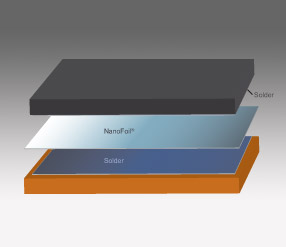 So, I figured while I'm at 30,000 feet in an airplane on free wi-fi (how long have we waited for this? Thank you AirTran®!), it would be a perfect time to make a few comments about bonding with NanoFoil® and the role that pressure plays in the NanoBond® process. Get it? Pressurized cabin? Bonding pressure?
So, I figured while I'm at 30,000 feet in an airplane on free wi-fi (how long have we waited for this? Thank you AirTran®!), it would be a perfect time to make a few comments about bonding with NanoFoil® and the role that pressure plays in the NanoBond® process. Get it? Pressurized cabin? Bonding pressure?If you remember the basics for a second, NanoFoil, whether it is standard or plated with tin solder on both sides, needs to be in intimate contact with the surfaces to be soldered. Once the NanoFoil is activated (at a thickness of 40 microns) it only stays at 1,500 degrees Celsius for less than a millisecond. So, if the NanoFoil is not in "intimate contact" with the interfaces that need to be soldered (or "wet"), it will not create a great bond. By applying pressure, you, the engineer, can maximize contact with the foil. The best way to do that is to use constant pressure and some foam or compliant material.
 Constant Pressure: If you were to personally witness the NanoBond process (imagine you are shrunk down to nano-size and can actually see the NanoFoil reaction begin), you would see a wave of molten solder propagating across the bond area as the reaction occurs. Now, if you were using two static plates to press the assembly together, there would be minimal constant downward pressure while the solder is molten. However, if you were using a spring-loaded, air-driven, or piston-driven pressing device, you would ensure that downward pressure was pressing the assembly together, enabling the molten solder to produce a high quality, low void bond.
Constant Pressure: If you were to personally witness the NanoBond process (imagine you are shrunk down to nano-size and can actually see the NanoFoil reaction begin), you would see a wave of molten solder propagating across the bond area as the reaction occurs. Now, if you were using two static plates to press the assembly together, there would be minimal constant downward pressure while the solder is molten. However, if you were using a spring-loaded, air-driven, or piston-driven pressing device, you would ensure that downward pressure was pressing the assembly together, enabling the molten solder to produce a high quality, low void bond.Foam (Compliant Material): If you remember nothing else about this flight-induced blog post remember this:
A COMPLIANT LAYER SPREADS THE LOAD EVENLY AND
HELPS TO MAKE THE MOST SUCCESSFUL NANOBOND.
It shouldn't be too much of a surprise to learn that, if y
 ou use some foam above your component as you are applying pressure, the load will be spread much more evenly.
ou use some foam above your component as you are applying pressure, the load will be spread much more evenly.Well that is all for now. Preparing for a landing. Not me, the pilot. All I have is this wi fi compatible laptop!
Image source.


